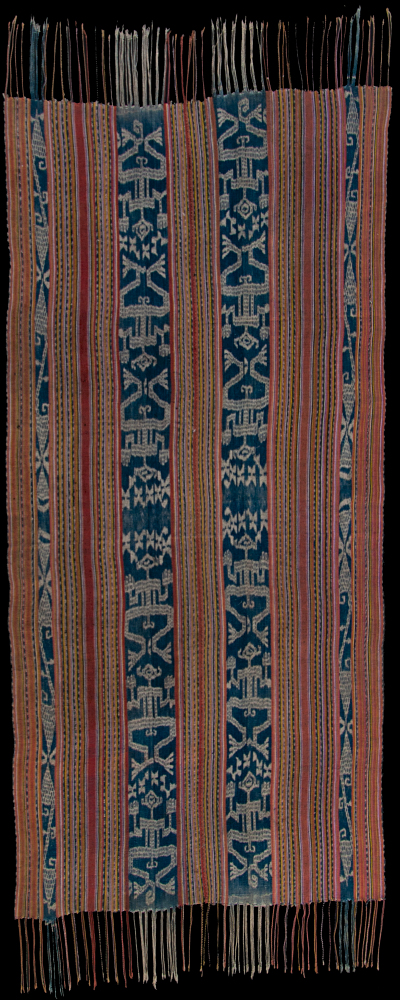| |
292 Timor, East Timor
Beti naek (men's wrap)  
|
| Locale: | Ambenu (Ocusi), the East-Timorese exclave in West-Timor. Village in the lower elevations. Atoni people. |
| Period: | 1950 or before |
| Yarn: | Medium hand-spun cotton for ikated areas, quad-ply commercial cotton for accent stripes |
| Technique: | Warp ikat |
| Panels: | 2 |
| Size: | 83 x 180 cm (2' 8" x 5' 10") LW: 2.17 |
| Weight: | 555 g (19.6 oz), 371 g/m2 (1.22 oz/ft2) |
| Design: | Beti of the type that Yeager and Jacobson call 'multiple design stripe', which is typical for Ambenu. The two widest ikated panels are decorated with the traditional Atoni 'katak' (lit. 'frog') motif, an anthropomorph made to look very much like a zoomorph - often in combination with smaller motifs of the same kind emerging from between the legs of the larger. They are generally interpreted as standing for the individual in his or her line of ancestry. The head may be depicted, as in this piece, or merely suggested. The two narrower ikated bands are decorated with looping figures (resembling Dongson motifs) of unknown significance. They may also represent crocodiles as these are a powerful totem on Timor and come in myriad forms from stylized figuration to deformation beyond recognition. The field is created by numerous stippled stripes in parallel, in a variety of pastel shades. |
| Comment: | This appears to be the first published example of Ambenu ikat with a katak motif (ten Hoopen 2023 [2022]: Fig. 000). The weaver has chosen a simple, yet decidedly uncommon method to achieve the asymmetry that in Ambenu appears to be more favoured than in Insana, Amanuban and other nearby parts of West Timor). She simply reversed one of the two identical warp skeins that were created in parallel. See image below, in which the rightmost panel was flipped vertically to show that the two are in fact identical. The dyes used are all natural, also those in the pinstripes. The cloth was clearly used for a long period, but well preserved. Twisted fringes. � |
| Background: | Chapters on Timor and East Timor. |
| Exhibited: | Timor: Totems and Tokens, Museu do Oriente, Lisbon, 2019/20. |
| Published: | Timor: Totems and Tokens, 2019.
Ikat Textiles of Timor: Indonesian and Timor-Leste, 2025. |
| Compare: | 002 169 118 256 189 |
| Sources: | A near identical menís wrap is identified as Amanuban (Khan Majlis 1984: Fig. 457). After reproduction and manipulation of Khan Majlisís image it could be established that asymmetry was likewise achieved by flipping part of the warp over its horizontal axis. The main motif is very similar to that on two other examples identified as Amanuban, both symmetric; one dated circa 1900 (ibid: Fig. 456) and one in Yeager & Jacobson, Textiles of Timor, Fig. 45i. But the motif is also found in Oecusse, e.g. in Taiboko (ibid.: Fig. 45j), and in several other parts of Timor peopled by Atoni. Field-collector Aja Bordeville on her website shows a sarong from Mollo (REF#MOL699) with a main motif that is very similar to the motif of the side bands in this piece.
 |
| |

©Peter ten Hoopen, 2024
All rights reserved.
|


